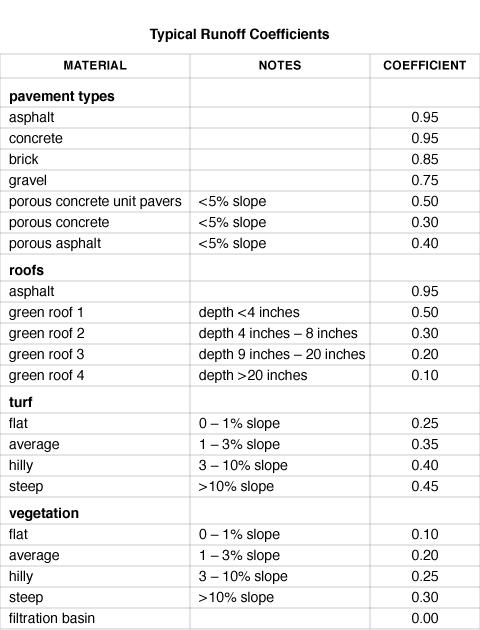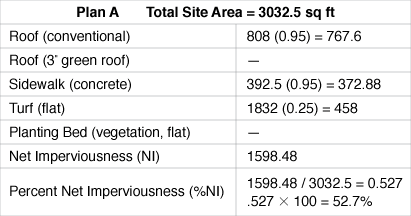Math questions / Soil permeability
What are the soil conditions and the native plants in a school's site?
Why is water runoff on a site an important idea when designing sustainable buildings?
[Note: We recommend that you complete the math question set on Water Runoff before working through these questions.]
The rainwater that falls on a site will either soak into the ground if the land is permeable (turf, vegetation), or run off if the material is impermeable (roof, pavement). No material or groundcover will completely absorb or shed all the water that falls on it, so the runoff coefficient measures the percentage of water that drains off. The higher the coefficient, the greater the amount of water will run off. A runoff coefficient of 0.40, for example, means that 40% of the water that falls on the material will run of, while 60% will be absorbed.
Landscape architects and architects typically want to minimize the amount of rainwater that runs off the site, because in most cities rainwater drains directly into the sewer system where it mixes with untreated sewage that must be processed and cleaned. A permeable landscape on the other hand, will allow the rainwater that naturally falls to support the plant life growing there.

Suppose that an architect is designing a small building addition presents the client with two possible options: Plan A or Plan B. The two plans and specifications differ in the amount of permeable and impermeable surfaces on the building and the site.

1.
In a few sentences, describe how the designs and materials on Plan A and Plan B are different.
One way to compare the two sites is to calculate the total percentage of water that will run off the building and its site. This number is called the Percent Net Imperviousness (%NI). It compares the total amount of runoff the plan will actually produce, with the amount of runoff the plan would produce if all the surfaces were completely impermeable, meaning all the water drains off.
Typically, architects want to achieve a lower Net Imperviousness number, because the lower the number, the more water will soak back into the ground. Calculating the Percent Net Imperviousness is done through three steps:
step a.
Multiply the area of each part of the building and the site by its Runoff Coefficient, as found in the Typical Runoff Coefficient chart above.
step b.
Total the results from Step a. This total equals the Net Imperviousness (NI), a measure of how much water runoff will be produced by the plan.
step c.
To produce the Percent Net Imperviousness (%NI), divide the Net Imperviousness (NI) by the Total Site Area, and convert the amount to a percent.
2.
The calculations for calculating Percent Net Imperviousness (%NI) for Plan A are given below. The result shows that 52.7% of the rainwater that falls on the site would run off using Plan A. Do the similar calculations for Plan B. (Note: Be sure to use the area figures found in Plan B, above problem 1.)


Architects use yet another measure, called the Percent Decrease in Net Imperviousness, which shows how the water runoff is decreased by using one plan compared with another. The formula below calculates this by using the Percent Net Imperviousness (%NI) for each plan.
![]()
3.
Find the Percent Decrease in Net Imperviousness that results when Plan B is used instead of Plan A.
4.
Suppose another site has an existing brick courtyard with an area of 950 square feet and an architect is considering whether to replace the brick with all turf or half turf. Calculate the Percent Net Imperviousness for the all brick courtyard.
5.
Calculate the Percent Net Imperviousness if half the courtyard is covered in turf and half is covered in brick.
6.
Calculate the Percent Decrease in Net Imperviousness that would result from the change.